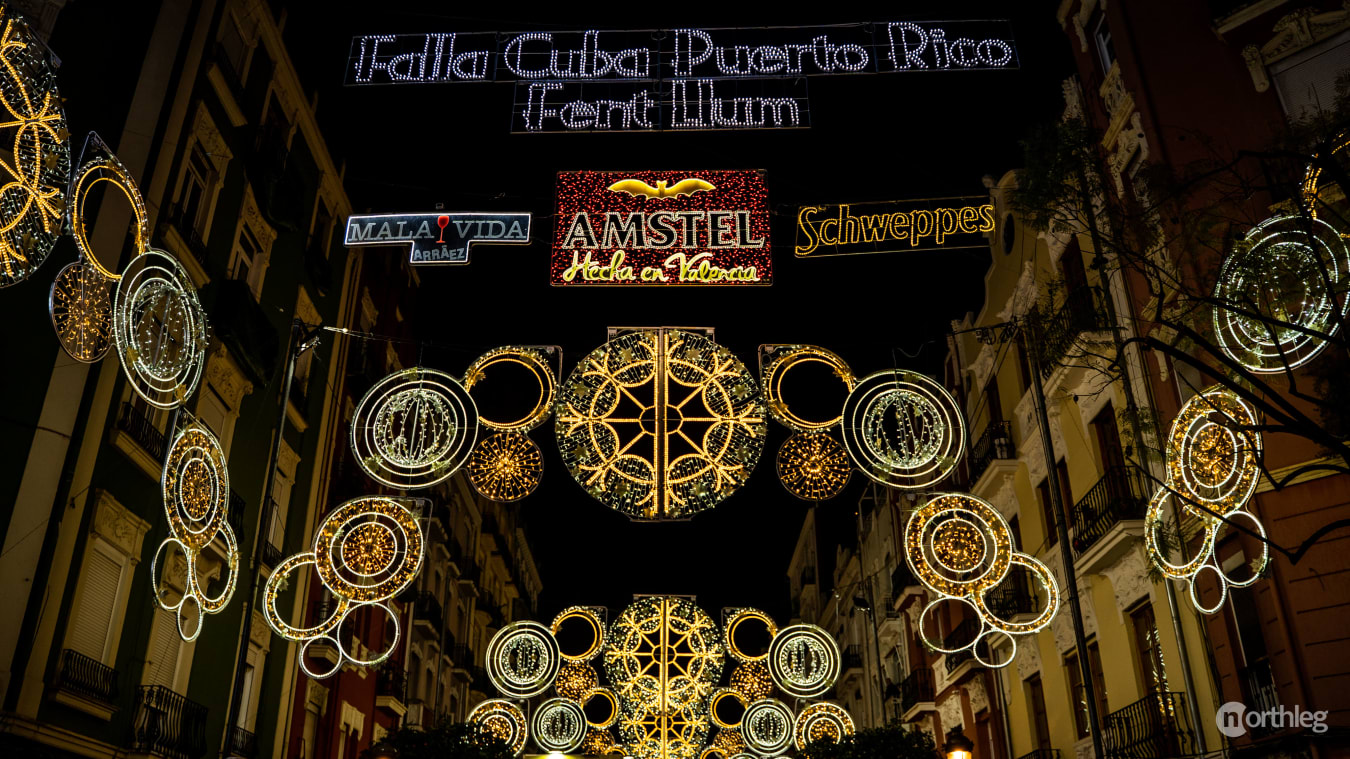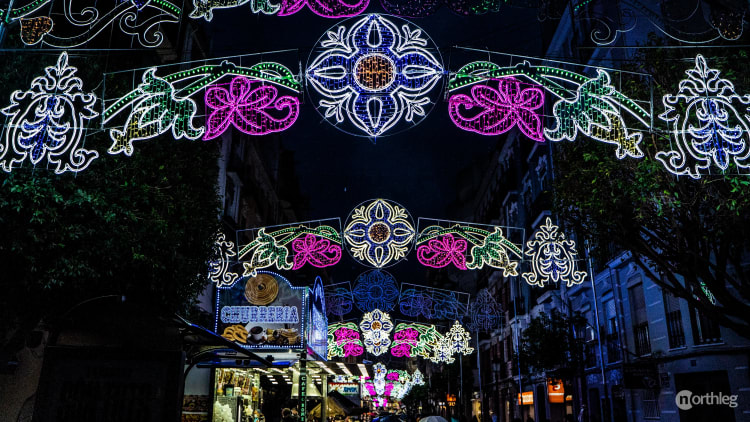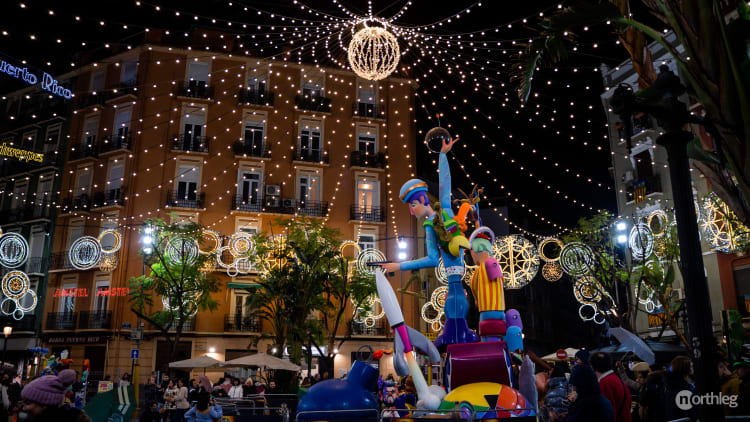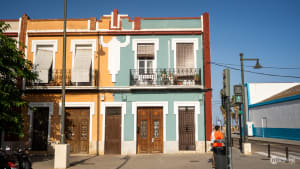
Fallas Streetlights
Even after the sun has set, there are no limits to the Fallas decorations in the city: streetlight installations illuminate the neighbourhoods during the festival.
Fallas Streetlights in a nutshell…
During Fallas, Valencia’s streets glow with stunning iluminaciones de barrios, elaborate light installations that mark the festival’s final days.
Location: Best displays in Russafa and Malvarrosa, including Sueca-Literato Azorín, Cuba-Puerto Rico, and Cádiz-Los Centelles.
Time: Mid-March (weekend before the Plantà, typically 8:00–9:00 PM.
Entry: Free, with special encendido de luces events featuring music and fireworks.
As the Semana Fallera, the closing week of the festival, approaches, the various Fallas committees prepare a show that is bound to leave the public in awe: the street illumination. Around numerous neighbourhoods all over Valencia, majestic streetlights are installed.
Each Falla works in collaboration with expert technicians from all over Spain and abroad to create these works of artistic illumination. Their point is to announce the imminent arrival of the Plantà and the final days of the festival. But the streetlights have become so appreciated that their inauguration constitutes an event in and of itself.

These are not just simple streetside decorations on traffic poles and trees. These are surprisingly intricate lighting projects. Hundreds of lightbulbs line up in heavy curtains, opening up to streets that resemble dream-like palace halls. Luminous vaults rise high above the asphalt and blankets quilted with colourful lights fill the space between buildings. Heavy chandeliers whose crystals are dozens of LED lights swing between the balconies.
Valencians and tourists flock to the streets to see the impressive structures and colourful shapes. From the biggest and most elaborate displays to the simpler and smaller installations, the Fallas streetlights are highly appreciated and people all over Valencia make a point of visiting as many as they can.
Several of these displays even enter a streetlight competition, organised annually by the Junta Central Fallera. The committees are sorted into two categories: A-Category for the bigger installations with a budget above €15,000, and B-Category for the smaller ones with a budget under €15,000.
In the case of the A-Category displays, it’s not uncommon to have several encendido de luces events, where the streetlights are turned on, accompanied by music and sometimes even fireworks. In case such an event is organised, the committees release an official programme days ahead to let the public know when they can see the show every night.
Practical Info
During Fallas anything makes for a good reason to celebrate, and the streetlight displays are no exception. Every year, the weekend before the Plantà, the participating Fallas committees make a big deal out of lighting up their streetlights, and the event takes the name of encendidos de luces.
The lights are normally lit up in rounds, meaning you get to see the lights being turned on several times during the same night, together with a brief music show or even some castillos de fuegos (firework display). Alternatively, what some Fallas do is turn on the lights and keep them up for the night.
The Best Streetlights
In Valencia, streetlight displays organised for the Fallas are sorted into two budget categories: the bigger ones, called A-Category, and the smaller B-Categories. Obviously, if you want to see the most impressive streetlights during Fallas, you have to go to an A-Category display.

The best shows can be found in the Russafa and Malvarrosa neighbourhoods. In particular, the Fallas committees we recommend you go see are Sueca-Literato Azorín, Cuba-Puerto Rico, Cuba-Literato Azorín, Cádiz-Los Centelles and Malvarrosa-Antonio Ponz-Cavite. These committees routinely compete to have the best display.
Schedule
The schedule for each encendido de luces varies every year, although you can generally expect streets to be lit up around 8:00 or 9:00 pm.
Frequently Asked Questions
Here you can find quick answers to all of your questions. Linked, you’ll find the articles or the sections of the articles that can give you more detailed information.
-
The term iluminaciones de barrios refers to the streetlights that are put up every year in Valencia during the Fallas festival.
-
The encendido de luces is the moment the streetlights are turned on in a particular street, revealing the installation’s design.
-
The Fallas committees that routinely compete to have the best display are Sueca-Literato Azorín, Cuba-Puerto Rico, Cuba-Literato Azorín, Cádiz-Los Centelles and Malvarrosa-Antonio Ponz-Cavite.
If you’d like to know more about the programme, you can check out the relevant section of this article.
-
The streetlight installations are all turned on at different times, so each year a schedule is released by the participating committees. In any case, you can expect most displays to be turned on between 8:00 pm and 9:00 pm.
If you’d like to have more details about the programme, you can check out the relevant section of this article.
-
It really does depend on the committee. Some of them are massive, while some of them are a bit simpler and smaller.
All the bigger installations are in the A-Category, meaning they cost more than €15,000.
-
Again, it depends on the committee and the budget. One of the biggest ones was the 2013 A-Category winner, Falla Cuba-Literato Azorín, which used 850,000 light bulbs for its installation.



















